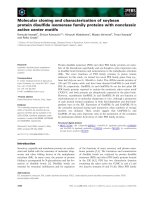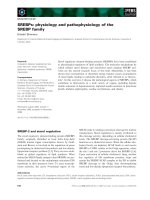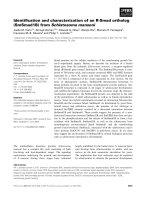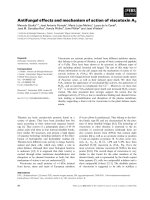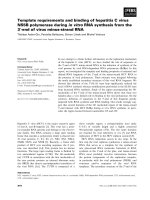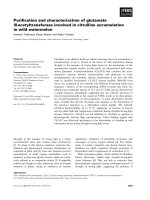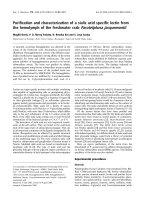Báo cáo khoa học: "Large-Scale Induction and Evaluation of Lexical Resources from the Penn-II Treebank" potx
Bạn đang xem bản rút gọn của tài liệu. Xem và tải ngay bản đầy đủ của tài liệu tại đây (71.98 KB, 8 trang )
Large-Scale Induction and Evaluation of Lexical Resources from the
Penn-II Treebank
Ruth O’Donovan, Michael Burke, Aoife Cahill, Josef van Genabith, Andy Way
National Centre for Language Technology and School of Computing
Dublin City University
Glasnevin
Dublin 9
Ireland
{rodonovan,mburke,acahill,josef,away}@computing.dcu.ie
Abstract
In this paper we present a methodology for ex-
tracting subcategorisation frames based on an
automatic LFG f-structure annotation algorithm
for the Penn-II Treebank. We extract abstract
syntactic function-based subcategorisation frames
(LFG semantic forms), traditional CFG category-
based subcategorisation frames as well as mixed
function/category-based frames, with or without
preposition information for obliques and particle in-
formation for particle verbs. Our approach does
not predefine frames, associates probabilities with
frames conditional on the lemma, distinguishes be-
tween active and passive frames, and fully reflects
the effects of long-distance dependencies in the
source data structures. We extract 3586 verb lem-
mas, 14348 semantic form types (an average of 4
per lemma) with 577 frame types. We present a
large-scale evaluation of the complete set of forms
extracted against the full COMLEX resource.
1 Introduction
Lexical resources are crucial in the construction
of wide-coverage computational systems based on
modern syntactic theories (e.g. LFG, HPSG, CCG,
LTAG etc.). However, as manual construction of
such lexical resources is time-consuming, error-
prone, expensive and rarely ever complete, it is of-
ten the case that limitations of NLP systems based
on lexicalised approaches are due to bottlenecks in
the lexicon component.
Given this, research on automating lexical acqui-
sition for lexically-based NLP systems is a partic-
ularly important issue. In this paper we present an
approach to automating subcategorisation frame ac-
quisition for LFG (Kaplan and Bresnan, 1982) i.e.
grammatical function-based systems. LFG has two
levels of structural representation: c(onstituent)-
structure, and f(unctional)-structure. LFG differ-
entiates between governable (argument) and non-
governable (adjunct) grammatical functions. Sub-
categorisation requirements are enforced through
semantic forms specifying the governable grammat-
ical functions required by a particular predicate (e.g.
FOCUS(↑ SUBJ)(↑ OBL
on
)). Our approach is
based on earlier work on LFG semantic form extrac-
tion (van Genabith et al., 1999) and recent progress
in automatically annotating the Penn-II treebank
with LFG f-structures (Cahill et al., 2004b). De-
pending on the quality of the f-structures, reliable
LFG semantic forms can then be generated quite
simply by recursively reading off the subcategoris-
able grammatical functions for each local pred
value at each level of embedding in the f-structures.
The work reported in (van Genabith et al., 1999)
was small scale (100 trees), proof of concept and
required considerable manual annotation work. In
this paper we show how the extraction process can
be scaled to the complete Wall Street Journal (WSJ)
section of the Penn-II treebank, with about 1 mil-
lion words in 50,000 sentences, based on the au-
tomatic LFG f-structure annotation algorithm de-
scribed in (Cahill et al., 2004b). In addition to ex-
tracting grammatical function-based subcategorisa-
tion frames, we also include the syntactic categories
of the predicate and its subcategorised arguments,
as well as additional details such as the prepositions
required by obliques, and particles accompanying
particle verbs. Our method does not predefine the
frames to be extracted. In contrast to many other
approaches, it discriminates between active and pas-
sive frames, properly reflects long distance depen-
dencies and assigns conditional probabilities to the
semantic forms associated with each predicate.
Section 2 reviews related work in the area of
automatic subcategorisation frame extraction. Our
methodology and its implementation are presented
in Section 3. Section 4 presents the results of our
lexical extraction. In Section 5 we evaluate the
complete extracted lexicon against the COMLEX
resource (MacLeod et al., 1994). To our knowl-
edge, this is the largest evaluation of subcategorisa-
tion frames for English. In Section 6, we conclude
and give suggestions for future work.
2 Related Work
Creating a (subcategorisation) lexicon by hand is
time-consuming, error-prone, requires considerable
linguistic expertise and is rarely, if ever, complete.
In addition, a system incorporating a manually con-
structed lexicon cannot easily be adapted to specific
domains. Accordingly, many researchers have at-
tempted to construct lexicons automatically, espe-
cially for English.
(Brent, 1993) relies on local morphosyntactic
cues (such as the -ing suffix, except where such a
word follows a determiner or a preposition other
than to) in the untagged Brown Corpus as proba-
bilistic indicators of six different predefined subcat-
egorisation frames. The frames do not include de-
tails of specific prepositions. (Manning, 1993) ob-
serves that Brent’s recognition technique is a “rather
simplistic and inadequate approach to verb detec-
tion, with a very high error rate”. Manning feeds
the output from a stochastic tagger into a finite state
parser, and applies statistical filtering to the parsing
results. He predefines 19 different subcategorisation
frames, including details of prepositions. Applying
this technique to approx. 4 million words of New
York Times newswire, Manning acquires 4900 sub-
categorisation frames for 3104 verbs, an average of
1.6 per verb. (Ushioda et al., 1993) run a finite state
NP parser on a POS-tagged corpus to calculate the
relative frequency of just six subcategorisation verb
classes. In addition, all prepositional phrases are
treated as adjuncts. For 1565 tokens of 33 selected
verbs, they report an accuracy rate of 83%.
(Briscoe and Carroll, 1997) observe that in the
work of (Brent, 1993), (Manning, 1993) and (Ush-
ioda et al., 1993), “the maximum number of distinct
subcategorization classes recognized is sixteen, and
only Ushioda et al. attempt to derive relative subcat-
egorization frequency for individual predicates”. In
contrast, the system of (Briscoe and Carroll, 1997)
distinguishes 163 verbal subcategorisation classes
by means of a statistical shallow parser, a classifier
of subcategorisation classes, and a priori estimates
of the probability that any verb will be a member
of those classes. More recent work by Korhonen
(2002) on the filtering phase of this approach has
improved results. Korhonen experiments with the
use of linguistic verb classes for obtaining more ac-
curate back-off estimates for use in hypothesis se-
lection. Using this extended approach, the average
results for 45 semantically classified test verbs eval-
uated against hand judgements are precision 87.1%
and recall 71.2%. By comparison, the average re-
sults for 30 verbs not classified semantically are pre-
cision 78.2% and recall 58.7%.
Carroll and Rooth (1998) use a hand-written
head-lexicalised context-free grammar and a text
corpus to compute the probability of particular sub-
categorisation scenarios. The extracted frames do
not contain details of prepositions.
More recently, a number of researchers have
applied similar techniques to derive resources for
other languages, especially German. One of these,
(Schulte im Walde, 2002), induces a computational
subcategorisation lexicon for over 14,000 German
verbs. Using sentences of limited length, she ex-
tracts 38 distinct frame types, which contain max-
imally three arguments each. The frames may op-
tionally contain details of particular prepositional
use. Her evaluation on over 3000 frequently occur-
ring verbs against the German dictionary Duden -
Das Stilw
¨
orterbuch is similar in scale to ours and is
discussed further in Section 5.
There has also been some work on extracting
subcategorisation details from the Penn Treebank.
(Kinyon and Prolo, 2002) introduce a tool which
uses fine-grained rules to identify the arguments,
including optional arguments, of each verb occur-
rence in the Penn Treebank, along with their syn-
tactic functions. They manually examined the 150+
possible sequences of tags, both functional and cat-
egorial, in Penn-II and determined whether the se-
quence in question denoted a modifier, argument or
optional argument. Arguments were then mapped
to traditional syntactic functions. As they do not in-
clude an evaluation, currently it is impossible to say
how effective this technique is.
(Xia et al., 2000) and (Chen and Vijay-Shanker,
2000) extract lexicalised TAGs from the Penn Tree-
bank. Both techniques implement variations on
the approaches of (Magerman, 1994) and (Collins,
1997) for the purpose of differentiating between
complement and adjunct. In the case of (Xia et al.,
2000), invalid elementary trees produced as a result
of annotation errors in the treebank are filtered out
using linguistic heuristics.
(Hockenmaier et al., 2002) outline a method for
the automatic extraction of a large syntactic CCG
lexicon from Penn-II. For each tree, the algorithm
annotates the nodes with CCG categories in a top-
down recursive manner. In order to examine the
coverage of the extracted lexicon in a manner simi-
lar to (Xia et al., 2000), (Hockenmaier et al., 2002)
compared the reference lexicon acquired from Sec-
tions 02-21 with a test lexicon extracted from Sec-
tion 23 of the WSJ. It was found that the reference
CCG lexicon contained 95.09% of the entries in the
test lexicon, while 94.03% of the entries in the test
TAG lexicon also occurred in the reference lexicon.
Both approaches involve extensive correction and
clean-up of the treebank prior to lexical extraction.
3 Our Methodology
The first step in the application of our methodology
is the production of a treebank annotated with LFG
f-structure information. F-structures are feature
structures which represent abstract syntactic infor-
mation, approximating to basic predicate-argument-
modifier structures. We utilise the automatic anno-
tation algorithm of (Cahill et al., 2004b) to derive
a version of Penn-II where each node in each tree
is annotated with an LFG functional annotation (i.e.
an attribute value structure equation). Trees are tra-
versed top-down, and annotation is driven by cate-
gorial, basic configurational, trace and Penn-II func-
tional tag information in local subtrees of mostly
depth one (i.e. CFG rules). The annotation proce-
dure is dependent on locating the head daughter, for
which the scheme of (Magerman, 1994) with some
changes and amendments is used. The head is anno-
tated with the LFG equation ↑=↓. Linguistic gen-
eralisations are provided over the left (the prefix)
and the right (suffix) context of the head for each
syntactic category occurring as the mother node of
such heads. To give a simple example, the rightmost
NP to the left of a VP head under an S is likely to
be its subject (↑ SUBJ =↓), while the leftmost NP
to the right of the V head of a VP is most proba-
bly its object (↑ OBJ =↓). (Cahill et al., 2004b)
provide four sets of annotation principles, one for
non-coordinate configurations, one for coordinate
configurations, one for traces (long distance depen-
dencies) and a final ‘catch all and clean up’ phase.
Distinguishing between argument and adjunct is an
inherent step in the automatic assignment of func-
tional annotations.
The satisfactory treatment of long distance de-
pendencies by the annotation algorithm is impera-
tive for the extraction of accurate semantic forms.
The Penn Treebank employs a rich arsenal of traces
and empty productions (nodes which do not re-
alise any lexical material) to co-index displaced ma-
terial with the position where it should be inter-
preted semantically. The algorithm of (Cahill et
al., 2004b) translates the traces into corresponding
re-entrancies in the f-structure representation (Fig-
ure 1). Passive movement is also captured and ex-
pressed at f-structure level using a passive:+ an-
notation. Once a treebank tree is annotated with
feature structure equations by the annotation algo-
rithm, the equations are collected and passed to a
constraint solver which produces the f-structures.
In order to ensure the quality of the seman-
S
S-TPC- 1
NP
U.N.
VP
V
signs
NP
treaty
NP
Det
the
N
headline
VP
V
said
S
T- 1
TOPIC
SUBJ
PRED U.N.
PRED sign
OBJ
PRED treaty
1
SUBJ
SPEC the
PRED headline
PRED say
COMP 1
Figure 1: Penn-II style tree with long distance depen-
dency trace and corresponding reentrancy in f-structure
tic forms extracted by our method, we must first
ensure the quality of the f-structure annotations.
(Cahill et al., 2004b) measure annotation quality
in terms of precision and recall against manually
constructed, gold-standard f-structures for 105 ran-
domly selected trees from section 23 of the WSJ
section of Penn-II. The algorithm currently achieves
an F-score of 96.3% for complete f-structures and
93.6% for preds-only f-structures.
1
Our semantic form extraction methodology is
based on the procedure of (van Genabith et al.,
1999): For each f-structure generated, for each
level of embedding we determine the local PRED
value and collect the subcategorisable grammat-
ical functions present at that level of embed-
ding. Consider the f-structure in Figure 1. From
this we recursively extract the following non-
empty semantic forms: say([subj,comp]),
sign([subj,obj]). In effect, in both (van
Genabith et al., 1999) and our approach seman-
tic forms are reverse engineered from automatically
generated f-structures for treebank trees. We ex-
tract the following subcategorisable syntactic func-
tions: SUBJ, OBJ, OBJ2, OBL
prep
, OBL2
prep
, COMP,
XCOMP and PART. Adjuncts (e.g. ADJ, APP etc)
are not included in the semantic forms. PART
is not a syntactic function in the strict sense but
we capture the relevant co-occurrence patterns of
verbs and particles in the semantic forms. Just
as OBL includes the prepositional head of the PP,
PART includes the actual particle which occurs e.g.
add([subj,obj,part:up]).
In the work presented here we substantially ex-
tend the approach of (van Genabith et al., 1999) as
1
Preds-only measures only paths ending in PRED:VALUE so
features such as number, person etc are not included.
regards coverage, granularity and evaluation: First,
we scale the approach of (van Genabith et al., 1999)
which was proof of concept on 100 trees to the full
WSJ section of the Penn-II Treebank. Second, our
approach fully reflects long distance dependencies,
indicated in terms of traces in the Penn-II Tree-
bank and corresponding re-entrancies at f-structure.
Third, in addition to abstract syntactic function-
based subcategorisation frames we compute frames
for syntactic function-CFG category pairs, both for
the verbal heads and their arguments and also gen-
erate pure CFG-based subcat frames. Fourth, our
method differentiates between frames captured for
active or passive constructions. Fifth, our method
associates conditional probabilities with frames.
In contrast to much of the work reviewed in the
previous section, our system is able to produce sur-
face syntactic as well as abstract functional subcat-
egorisation details. To incorporate CFG details into
the extracted semantic forms, we add an extra fea-
ture to the generated f-structures, the value of which
is the syntactic category of the pred at each level
of embedding. Exploiting this information, the ex-
tracted semantic form for the verb sign looks as fol-
lows: sign(v,[subj(np),obj(np)]).
We have also extended the algorithm to deal with
passive voice and its effect on subcategorisation be-
haviour. Consider Figure 2: not taking voice into
account, the algorithm extracts an intransitive frame
outlaw([subj]) for the transitive outlaw. To
correct this, the extraction algorithm uses the fea-
ture value pair passive:+, which appears in the
f-structure at the level of embedding of the verb in
question, to mark that predicate as occurring in the
passive: outlaw([subj],p).
In order to estimate the likelihood of the cooc-
currence of a predicate with a particular argument
list, we compute conditional probabilities for sub-
categorisation frames based on the number of token
occurrences in the corpus. Given a lemma l and an
argument list s, the probability of s given l is esti-
mated as:
P(s|l) :=
count(l, s)
n
i=1
count(l, s
i
)
We use thresholding to filter possible error judge-
ments by our system. Table 1 shows the attested
semantic forms for the verb accept with their as-
sociated conditional probabilities. Note that were
the distinction between active and passive not taken
into account, the intransitive occurrence of accept
would have been assigned an unmerited probability.
subj : spec : quant : pred : all
adjunct : 2 : pred : almost
adjunct : 3 : pred : remain
participle : pres
4 : obj : adjunct : 5 : pred : cancer-causing
pers : 3
pred : asbestos
num : sg
pform : of
pers : 3
pred : use
num : pl
passive : +
adjunct : 1 : obj : pred : 1997
pform : by
xcomp : subj : spec: quant : pred : all
adjunct : 2 : pred : almost
passive : +
xcomp : subj : spec: quant : pred : all
adjunct : 2 : pred : almost
passive : +
pred : outlaw
tense : past
pred : be
pred : will
modal : +
Figure 2: Automatically generated f-structure
for the string wsj 0003 23“By 1997, almost
all remaining uses of cancer-causing
asbestos will be outlawed.”
Semantic Form Frequency Probability
accept([subj,obj]) 122 0.813
- accept([subj],p) 9 0.060
accept([subj,comp]) 5 0.033
- accept([subj,obl:as],p) 3 0.020
accept([subj,obj,obl:as]) 3 0.020
accept([subj,obj,obl:from]) 3 0.020
- accept([subj]) 2 0.013
accept([subj,obj,obl:at]) 1 0.007
accept([subj,obj,obl:for]) 1 0.007
accept([subj,obj,xcomp]) 1 0.007
Table 1: Semantic Forms for the verb accept marked
with p for passive use.
4 Results
We extract non-empty semantic forms
2
for 3586
verb lemmas and 10969 unique verbal semantic
form types (lemma followed by non-empty argu-
ment list). Including prepositions associated with
the OBLs and particles, this number rises to 14348,
an average of 4.0 per lemma (Table 2). The num-
ber of unique frame types (without lemma) is 38
without specific prepositions and particles, 577 with
(Table 3). F-structure annotations allow us to distin-
guish passive and active frames.
5 COMLEX Evaluation
We evaluated our induced (verbal) semantic forms
against COMLEX (MacLeod et al., 1994). COM-
2
Frames with at least one subcategorised grammatical func-
tion.
Without Prep/Part With Prep/Part
Sem. Form Types 10969 14348
Active 8516 11367
Passive 2453 2981
Table 2: Number of Semantic Form Types
Without Prep/Part With Prep/Part
# Frame Types 38 577
# Singletons 1 243
# Twice Occurring 1 84
# Occurring max. 5 7 415
# Occurring > 5 31 162
Table 3: Number of Distinct Frames for Verbs (not in-
cluding syntactic category for grammatical function)
LEX defines 138 distinct verb frame types without
the inclusion of specific prepositions or particles.
The following is a sample entry for the verb
reimburse:
(VERB :ORTH “reimburse” :SUBC ((NP-NP)
(NP-PP :PVAL (“for”))
(NP)))
Each verb has a :SUBC feature, specifying
its subcategorisation behaviour. For example,
reimburse can occur with two noun phrases
(NP-NP), a noun phrase and a prepositional phrase
headed by “for” (NP-PP :PVAL (“for”)) or a single
noun phrase (NP). Note that the details of the subject
noun phrase are not included in COMLEX frames.
Each of the complement types which make up the
value of the :SUBC feature is associated with a for-
mal frame definition which looks as follows:
(vp-frame np-np :cs ((np 2)(np 3))
:gs (:subject 1 :obj 2 :obj2 3)
:ex “she asked him his name”)
The value of the :cs feature is the constituent struc-
ture of the subcategorisation frame, which lists the
syntactic CF-PSG constituents in sequence. The
value of the :gs feature is the grammatical struc-
ture which indicates the functional role played by
each of the CF-PSG constituents. The elements of
the constituent structure are indexed, and referenced
in the :gs field. This mapping between constituent
structure and functional structure makes the infor-
mation contained in COMLEX suitable as an eval-
uation standard for the LFG semantic forms which
we induce.
5.1 COMLEX-LFG Mapping
We devised a common format for our induced se-
mantic forms and those contained in COMLEX.
This is summarised in Table 4. COMLEX does
not distinguish between obliques and objects so we
converted Obj
i
to OBL
i
as required. In addition,
COMLEX does not explicitly differentiate between
COMPs and XCOMPs, but does encode control in-
formation for any Comps which occur, thus allow-
ing us to deduce the distinction automatically. The
manually constructed COMLEX entries provided us
with a gold standard against which we evaluated the
automatically induced frames for the 2992 (active)
verbs that both resources have in common.
LFG COMLEX Merged
SUBJ Subject SUBJ
OBJ Object OBJ
OBJ2 Obj2 OBJ2
OBL Obj3 OBL
OBL2 Obj4 OBL2
COMP Comp COMP
XCOMP Comp XCOMP
PART Part PART
Table 4: COMLEX and LFG Syntactic Functions
We use the computed conditional probabilities to set
a threshold to filter the selection of semantic forms.
As some verbs occur less frequently than others we
felt it was important to use a relative rather than ab-
solute threshold. For a threshold of 1%, we disre-
gard any frames with a conditional probability of
less than or equal to 0.01. We carried out the evalu-
ation in a similar way to (Schulte im Walde, 2002).
The scale of our evaluation is comparable to hers.
This allows us to make tentative comparisons be-
tween our respective results. The figures shown in
Table 5 are the results of three different kinds of
evaluation with the threshold set to 1% and 5%. The
effect of the threshold increase is obvious in that
Precision goes up for each of the experiments while
Recall goes down.
For Exp 1, we excluded prepositional phrases en-
tirely from the comparison, i.e. assumed that PPs
were adjunct material (e.g. [subj,obl:for] becomes
[subj]). Our results are better for Precision than for
Recall compared to Schulte im Walde (op cit.), who
reports Precision of 74.53%, Recall of 69.74% and
an F-score of 72.05%.
Exp 2 includes prepositional phrases but not
parameterised for particular prepositions (e.g.
[subj,obl:for] becomes [subj,obl]). While our fig-
ures for Recall are again lower, our results for
Precision are considerably higher than those of
Schulte im Walde (op cit.) who recorded Preci-
sion of 60.76%, Recall of 63.91% and an F-score
of 62.30%.
For Exp. 3, we used semantic forms which con-
tained details of specific prepositions for any sub-
categorised prepositional phrase. Our Precision fig-
ures are again high (in comparison to 65.52% as
recorded by (Schulte im Walde, 2002)). However,
Threshold 1% Threshold 5%
P R F-Score P R F-Score
Exp. 1 79.0% 59.6% 68.0% 83.5% 54.7% 66.1%
Exp. 2 77.1% 50.4% 61.0% 81.4% 44.8% 57.8%
Exp. 2a 76.4% 44.5% 56.3% 80.9% 39.0% 52.6%
Exp. 3 73.7% 22.1% 34.0% 78.0% 18.3% 29.6%
Exp. 3a 73.3% 19.9% 31.3% 77.6% 16.2% 26.8%
Table 5: COMLEX Comparison
our Recall is very low (compared to the 50.83% that
Schulte im Walde (op cit.) reports). Consequently
our F-score is also low (Schulte im Walde (op cit.)
records an F-score of 57.24%). Experiments 2a and
3a are similar to Experiments 2 and 3 respectively
except they include the specific particle associated
with each PART.
5.1.1 Directional Prepositions
There are a number of possible reasons for our
low recall scores for Experiment 3 in Table 5. It
is a well-documented fact (Briscoe and Carroll,
1997) that subcategorisation frames (and their fre-
quencies) vary across domains. We have extracted
frames from one domain (the WSJ) whereas COM-
LEX was built using examples from the San Jose
Mercury News, the Brown Corpus, several literary
works from the Library of America, scientific ab-
stracts from the U.S. Department of Energy, and
the WSJ. For this reason, it is likely to contain
a greater variety of subcategorisation frames than
our induced lexicon. It is also possible that due
to human error COMLEX contains subcategorisa-
tion frames, the validity of which may be in doubt.
This is due to the fact that the aim of the COMLEX
project was to construct as complete a set of subcat-
egorisation frames as possible, even for infrequent
verbs. Lexicographers were allowed to extrapo-
late from the citations found, a procedure which
is bound to be less certain than the assignment of
frames based entirely on existing examples. Our re-
call figure was particularly low in the case of eval-
uation using details of prepositions (Experiment 3).
This can be accounted for by the fact that COMLEX
errs on the side of overgeneration when it comes to
preposition assignment. This is particularly true of
directional prepositions, a list of 31 of which has
been prepared and is assigned in its entirety by de-
fault to any verb which can potentially appear with
any directional preposition. In a subsequent exper-
iment, we incorporate this list of directional prepo-
sitions by default into our semantic form induction
process in the same way as the creators of COM-
LEX have done. Table 6 shows the results of this
experiment. As expected there is a significant im-
Precision Recall F-Score
Experiment 3 81.7% 40.8% 54.4%
Experiment 3a 83.1% 35.4% 49.7%
Table 6: COMLEX Comparison using p-dir(Threshold
of 1%)
Passive Precision Recall F-Score
Experiment 2 80.2% 54.7% 65.1%
Experiment 2a 79.7% 46.2% 58.5%
Experiment 3 72.6% 33.4% 45.8%
Experiment 3a 72.3% 29.3% 41.7%
Table 7: Passive evaluation (Threshold of 1%)
provement in the recall figure, being almost double
the figures reported in Table 5 for Experiments 3
and 3a.
5.1.2 Passive Evaluation
Table 7 presents the results of our evaluation of
the passive semantic forms we extract. It was
carried out for 1422 verbs which occur with pas-
sive frames and are shared by the induced lexicon
and COMLEX. As COMLEX does not provide ex-
plicit passive entries, we applied Lexical Redun-
dancy Rules (Kaplan and Bresnan, 1982) to auto-
matically convert the active COMLEX frames to
their passive counterparts. For example, the COM-
LEX entry see([subj,obj]) is converted to
see([subj]). The resulting precision is very
high, a slight increase on that for the active frames.
The recall score drops for passive frames (from
54.7% to 29.3%) in a similar way to that for active
frames when prepositional details are included.
5.2 Lexical Accession Rates
As well as evaluating the quality of our extracted
semantic forms, we also examine the rate at which
they are induced. (Charniak, 1996) and (Krotov et
al., 1998) observed that treebank grammars (CFGs
extracted from treebanks) are very large and grow
with the size of the treebank. We were interested in
discovering whether the acquisition of lexical mate-
rial on the same data displays a similar propensity.
Figure 3 displays the accession rates for the seman-
tic forms induced by our method for sections 0–24
of the WSJ section of the Penn-II treebank. When
we do not distinguish semantic forms by category,
all semantic forms together with those for verbs dis-
play smaller accession rates than for the PCFG.
We also examined the coverage of our system in
a similar way to (Hockenmaier et al., 2002). We ex-
tracted a verb-only reference lexicon from Sections
02-21 of the WSJ and subsequently compared this
to a test lexicon constructed in the same way from
0
5000
10000
15000
20000
25000
0 5 10 15 20 25
No. of SFs/Rules
WSJ Section
All SF Frames
All Verbs
All SF Frames, no category
All Verbs, no category
PCFG
Figure 3: Accession Rates for Semantic Forms and CFG
Rules
Entries also in reference lexicon: 89.89%
Entries not in reference lexicon: 10.11%
Known words: 7.85%
- Known words, known frames: 7.85%
- Known words, unknown frames: -
Unknown words: 2.32%
- Unknown words, known frames: 2.32%
- Unknown words, unknown frames: -
Table 8: Coverage of induced lexicon on unseen
data (Verbs Only)
Section 23. Table 8 shows the results of this ex-
periment. 89.89% of the entries in the test lexicon
appeared in the reference lexicon.
6 Conclusions
We have presented an algorithm and its implementa-
tion for the extraction of semantic forms or subcate-
gorisation frames from the Penn-II Treebank, auto-
matically annotated with LFG f-structures. We have
substantially extended an earlier approach by (van
Genabith et al., 1999). The original approach was
small-scale and ‘proof of concept’. We have scaled
our approach to the entire WSJ Sections of Penn-
II (50,000 trees). Our approach does not predefine
the subcategorisation frames we extract as many
other approaches do. We extract abstract syntac-
tic function-based subcategorisation frames (LFG
semantic forms), traditional CFG category-based
frames as well as mixed function-category based
frames. Unlike many other approaches to subcate-
gorisation frame extraction, our system properly re-
flects the effects of long distance dependencies and
distinguishes between active and passive frames.
Finally our system associates conditional probabil-
ities with the frames we extract. We carried out an
extensive evaluation of the complete induced lexi-
con (not just a sample) against the full COMLEX
resource. To our knowledge, this is the most exten-
sive qualitative evaluation of subcategorisation ex-
traction in English. The only evaluation of a similar
scale is that carried out by (Schulte im Walde, 2002)
for German. Our results compare well with hers.
We believe our semantic forms are fine-grained and
by choosing to evaluate against COMLEX we set
our sights high: COMLEX is considerably more
detailed than the OALD or LDOCE used for other
evaluations.
Currently work is under way to extend the cov-
erage of our acquired lexicons by applying our
methodology to the Penn-III treebank, a more bal-
anced corpus resource with a number of text gen-
res (in addition to the WSJ sections). It is impor-
tant to realise that the induction of lexical resources
is part of a larger project on the acquisition of
wide-coverage, robust, probabilistic, deep unifica-
tion grammar resources from treebanks. We are al-
ready using the extracted semantic forms in parsing
new text with robust, wide-coverage PCFG-based
LFG grammar approximations automatically ac-
quired from the f-structure annotated Penn-II tree-
bank (Cahill et al., 2004a). We hope to be able to
apply our lexical acquisition methodology beyond
existing parse-annotated corpora (Penn-II and Penn-
III): new text is parsed by our PCFG-based LFG ap-
proximations into f-structures from which we can
then extract further semantic forms. The work re-
ported here is part of the core component for boot-
strapping this approach.
As the extraction algorithm we presented derives
semantic forms at f-structure level, it is easily ap-
plied to other, even typologically different, lan-
guages. We have successfully ported our automatic
annotation algorithm to the TIGER Treebank, de-
spite German being a less configurational language
than English, and extracted wide-coverage, proba-
bilistic LFG grammar approximations and lexical
resources for German (Cahill et al., 2003). Cur-
rently, we are migrating the technique to Spanish,
which has freer word order than English and less
morphological marking than German. Preliminary
results have been very encouraging.
7 Acknowledgements
The research reported here is supported by Enter-
prise Ireland Basic Research Grant SC/2001/186
and an IRCSET PhD fellowship award.
References
M. Brent. 1993. From Grammar to Lexicon: Unsu-
pervised Learning of Lexical Syntax. Computa-
tional Linguistics, 19(2):203–222.
E. Briscoe and J. Carroll. 1997. Automatic Extrac-
tion of Subcategorization from Corpora. In Pro-
ceedings of the 5th ACL Conference on Applied
Natural Language Processing, pages 356–363,
Washington, DC.
A. Cahill, M. Forst, M. McCarthy, R. O’Donovan,
C. Rohrer, J. van Genabith, and A. Way.
2003. Treebank-Based Multilingual Unification-
Grammar Development. In Proceedings of the
Workshop on Ideas and Strategies for Multilin-
gual Grammar Development at the 15th ESSLLI,
pages 17–24, Vienna, Austria.
A. Cahill, M. Burke, R. O’Donovan, J. van Gen-
abith, and A. Way. 2004a. Long-Distance De-
pendency Resolution in Automatically Acquired
Wide-Coverage PCFG-Based LFG Approxima-
tions. In Proceedings of the 42nd Annual Con-
ference of the Association for Computational Lin-
guistics (ACL-04), Barcelona, Spain.
A. Cahill, M. McCarthy, M. Burke, R. O’Donovan,
J. van Genabith, and A. Way. 2004b. Evaluating
Automatic F-Structure Annotation for the Penn-
II Treebank. Journal of Research on Language
and Computation.
G. Carroll and M. Rooth. 1998. Valence Induc-
tion with a Head-Lexicalised PCFG. In Proceed-
ings of the 3rd Conference on Empirical Meth-
ods in Natural Language Processing, pages 36–
45, Granada, Spain.
E. Charniak. 1996. Tree-bank Grammars. In AAAI-
96: Proceedings of the Thirteenth National Con-
ference on Artificial Intelligence, MIT Press,
pages 1031–1036, Cambridge, MA.
J. Chen and K. Vijay-Shanker. 2000. Automated
Extraction of TAGs from the Penn Treebank. In
Proceedings of the 38th Annual Meeting of the
Association of Computational Linguistics, pages
65–76, Hong Kong.
M. Collins. 1997. Three generative lexicalised
models for statistical parsing. In Proceedings of
the 35th Annual Meeting of the Association for
Computational Linguistics, pages 16–23.
J. Hockenmaier, G. Bierner, and J. Baldridge. 2002.
Extending the Coverage of a CCG System. Jour-
nal of Language and Computation, (2).
R. Kaplan and J. Bresnan. 1982. Lexical Func-
tional Grammar: A Formal System for Gram-
matical Representation. In Joan Bresnan, editor,
The Mental Representation of Grammatical Re-
lations, pages 206–250. MIT Press, Cambridge,
MA, Mannheim, 8th Edition.
A. Kinyon and C. Prolo. 2002. Identifying Verb Ar-
guments and their Syntactic Function in the Penn
Treebank. In Proceedings of the 3rd LREC Con-
ference, pages 1982–1987, Las Palmas, Spain.
A. Korhonen. 2002. Subcategorization Acquisition.
PhD thesis published as Techical Report UCAM-
CL-TR-530, Computer Laboratory, University of
Cambridge, UK.
A. Krotov, M. Hepple, R. Gaizauskas, and Y. Wilks.
1998. Compacting the Penn Treebank Grammar.
In Proceedings of COLING-ACL’98, pages 669–
703, Montreal, Canada.
C. MacLeod, R. Grishman, and A. Meyers. 1994.
The Comlex Syntax Project: The First Year. In
Proceedings of the ARPA Workshop on Human
Language Technology, pages 669–703, Prince-
ton, NJ.
D. Magerman. 1994. Natural Language Parsing
as Statistical Pattern Recognition. PhD Thesis,
Stanford University, CA.
C. Manning. 1993. Automatic Acquisition of a
Large Subcategorisation Dictionary from Cor-
pora. In Proceedings of the 31st Annual Meeting
of the Association for Computational Linguistics,
pages 235–242, Columbus, OH.
S. Schulte im Walde. 2002. Evaluating Verb Sub-
categorisation Frames learned by a German Sta-
tistical Grammar against Manual Definitions in
the Duden Dictionary. In Proceedings of the 10th
EURALEX International Congress, pages 187–
197, Copenhagen, Denmark.
A. Ushioda, D. Evans, T. Gibson, and A. Waibel.
1993. The Automatic Acquisition of Frequencies
of Verb Subcategorization Frames from Tagged
Corpora. In SIGLEX ACL Workshop on the Ac-
quisition of Lexical Knowledge from Text, pages
95–106, Columbus, OH.
J. van Genabith, A. Way, and L. Sadler. 1999. Data-
driven Compilation of LFG Semantic Forms. In
EACL-99 Workshop on Linguistically Interpreted
Corpora, pages 69–76, Bergen, Norway.
F. Xia, M. Palmer, and A. Joshi. 2000. A Uniform
Method of Grammar Extraction and its Applica-
tions. In Proceedings of the Conference on Em-
pirical Methods in Natural Language Processing
(EMNLP-2000), pages 53–62, Hong Kong.


